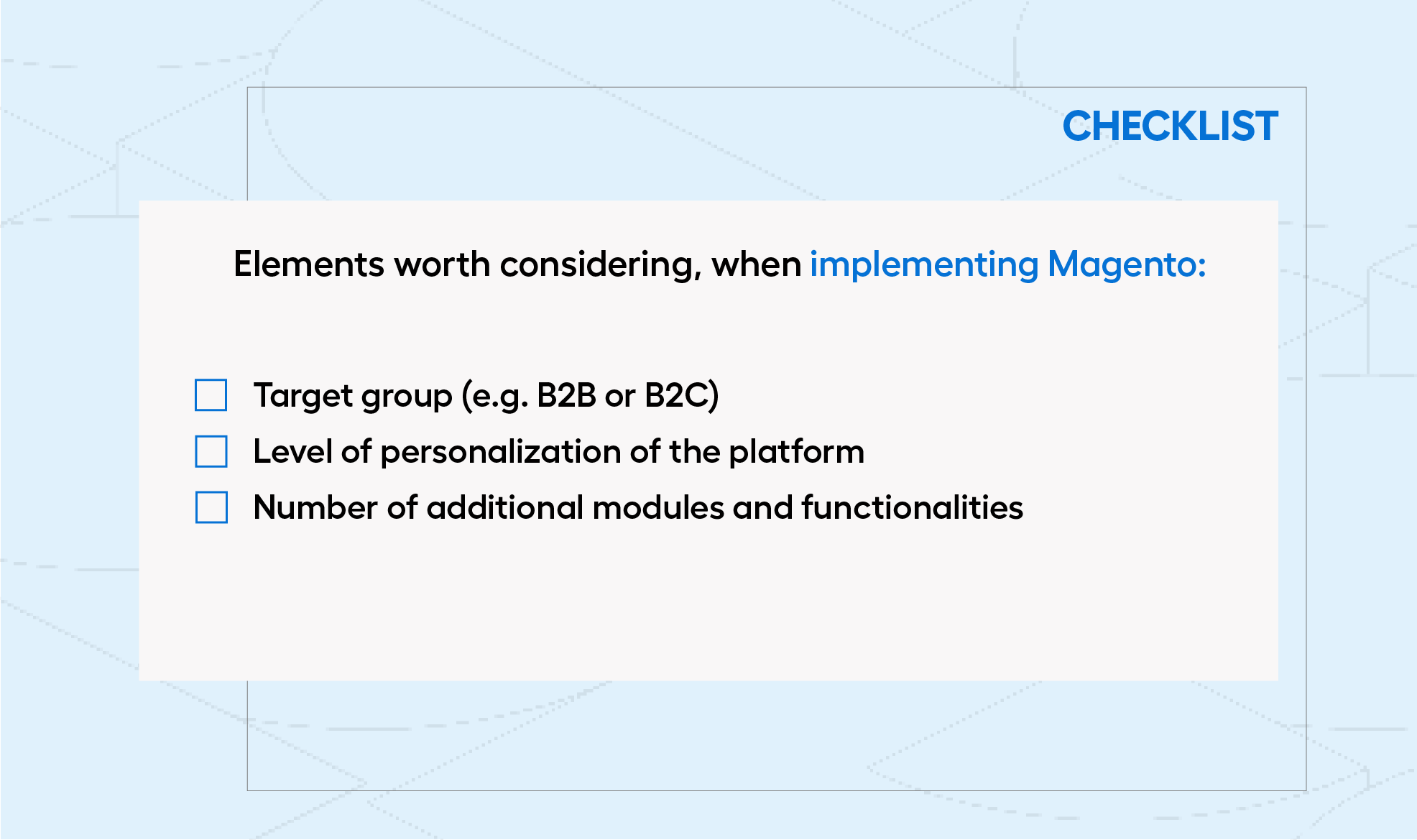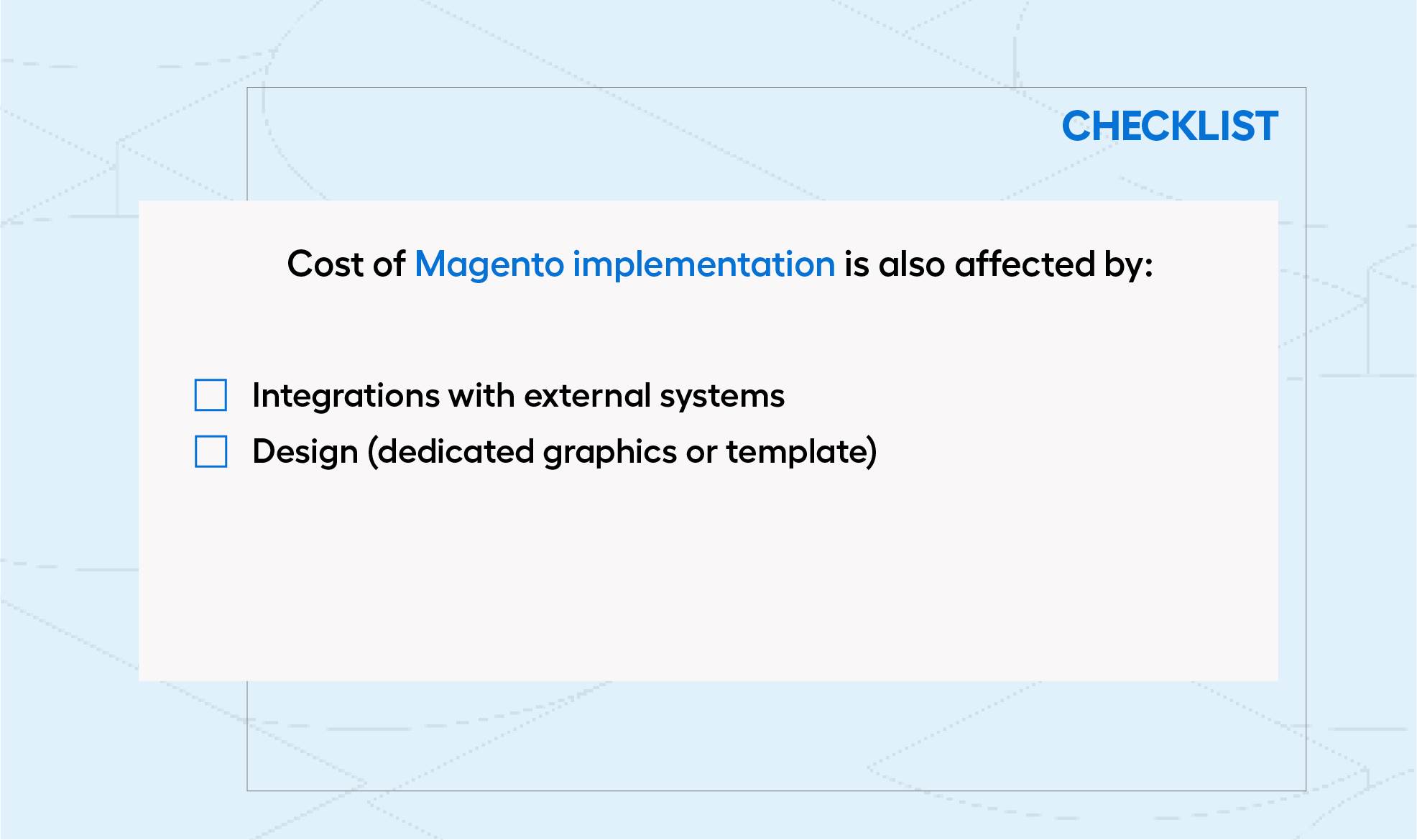How much does Magento cost - what determines the price of an online store on the Adobe Commerce platform?
Magento, or rather Adobe Commerce, is one of the most flexible and powerful eCommerce platforms available on the market. It has been at the top of Gartner's "Magic Quadrant for Digital Commerce" report for several years. What accounts for Magento's widespread popularity and attracts leaders from various industries like Nike, Ford, T-Mobile, and Coca-Cola to choose it? First of all, the engine provided by Adobe adapts to a variety of business needs. As a result, it can meet the complex demands and needs of eCommerce entrepreneurs. The flexibility of Magento can also largely affect the cost of implementing the platform. If you are looking for answers to questions such as: "How much does Magento cost?" or "Is it worth investing in Adobe Commerce?" - this article will help you clear up your doubts on the subject.
What does a professional valuation of the Magento platform look like?
When choosing a specific engine for your online store, you need to keep in mind that you are deciding on a foundation that will allow you to build an online store. Only at the next stage, you can customise the software to suit your needs, choosing from various customization options, additional plug-ins and functionalities. It is these factors that affect the final cost of implementation. Depending on the level of complexity of the project, the number of programming hours (as well as those of the Project Manager, testing, graphic designers) for a B2C project is a minimum of 700, while for a B2B platform the range starts at 1300 hours.
Keep in mind that the quoted amounts are only a range. The way a Magento project is priced can vary significantly depending on the individual practices of each software house. The final pricing is influenced not only by the number of developer hours needed to complete the project, but also by other factors that translate into the quality and scope of the service - this may include the software house's experience in specific implementations or the complexity of integration with external systems. In addition, individual pricing can also be influenced by:
- type of the project - larger projects that require many development hours allow for a more favourable price,
- scope of cooperation - the cost of implementation can be affected by the approach to the project, e.g. whether it includes a pre-implementation analysis,
- business development - depending on whether the store is implemented "from 0", the platform needs to be moved to another engine, its newer version (e.g. from Magento 1 to Magento 2), or there is only a need to improve the existing site, the cost may also change,
- individual needs - in each case, the final factor will always be the individual needs of the business, i.e. additional integrations, design, dedicated modules.
It is important to carefully discuss all aspects of the project, identify the client's priorities and expectations, and find a solution that meets the budget and business goals. A good software house will be able to tailor its Magento project quote to meet specific needs and resources.
What elements make up the Magento price?
When pricing platforms built on Adobe Commerce, follow a basic rule - the more extensive and personalised your platform is, the higher the costs associated with its implementation will be. Putting your store on Magento can be treated as an investment - with its extensive catalogue of functionalities and customization options, Magento can help you achieve your long-term business goals. What can its value depend on?

Target group and store type
Is your store's offering aimed at business-to-business (B2B) or individual consumers (B2C)? The answer to this question can largely determine the cost of implementing Magento. In both cases, the design of the platform requires a different approach and, consequently, the development of other tools and functionalities. In the case of a B2B platform, for example, these will include additional modules such as individual price lists for contractors or the ability to pay using merchant limits. In the case of B2C sales, important features will include: seamless purchasing processes, extensive customer service tools and effective solutions for creating personalised marketing and promotions.
Selected solutions and functionalities
The choice of specific solutions and functionalities is a key element of project pricing. As you already know - the price of Magento is directly related to the number and complexity of the e-store components you decide on. For example, if you decide to implement an international store functionalities, you may need to invest in Magento Multistore. Although the Multistore solution itself is available at no additional cost, adapting the store to international standards and requirements generates additional costs.
In addition, it may also be that the store will need a completely new, fully customised module. This could be, for example: a dedicated discount system or loyalty program, a unique way of presenting an offer or an extensive search engine. Deciding on such solutions, you have to expect that their development will be more time-consuming and will require more work from the development team, but it can significantly increase the competitiveness of your store and satisfy customer requirements.

Integrations with external systems
Running an online store is not just about presenting and selling products online. It's a complex process that also includes: managing warehouses, logistics (often not only within the country) or accounting. Magento allows integration with external systems that automate and streamline each of these areas. Implementing solutions such as WMS, ERP or CRM involves higher costs, but allows you to create an optimal environment for running an online business. How. Integration with external systems optimizes business processes, minimizes errors, and allows you to scale your business in the future.
Design
Equally important (and affecting the cost of platform implementation) besides technical issues and functionality is design. The aesthetics of an online store are important, especially if you want to develop an exceptional user experience. When setting up a store on Magento, you can choose between using a ready-made template or creating a custom layout.
If you care about uniqueness, custom design may be key, although it will cost more. This way you will gain full control over every element of the site - from the layout of the page to the specific interactions of users. However, you have to expect that custom layouts require time and effort on the part of UX designers and developers, which can significantly increase the cost of implementation. For eCommerce stores with limited budgets, ready-made templates can be a reasonable solution, allowing you to quickly launch your store at a lower cost (although with some restrictions in terms of customization).
Not just code - what else affects the cost of Magento implementation?
Implementing an eCommerce platform on Magento is much more than just writing code and launching an online store. The cost of the project and its ultimate success is also affected by such factors as:
- hosting - choosing the right hosting is crucial to the performance and stability of your store on Magento. Hosting costs are an integral part of your expenses, especially if you want to prepare for the growing traffic on the platform.
- security - expenses related to SSL certificates, firewall security and regular software updates are a necessity that should be included in the total cost of maintenance.
- testing - implementing Magento requires setting up test environments, running functional and performance tests, and making any adjustments. These stages of the project take time and resources, but are necessary to ensure the quality and efficiency of the store. Their cost is most often already included in the price.
- SLA - the decision to constantly monitor the store to detect possible errors in daily operation may increase the cost of the project, but is essential to ensure better service quality and customer satisfaction.
How much will you pay for Magento?
The Adobe Commerce engine is a tool that allows you to consistently adapt to changing market trends while providing an exceptional shopping experience for your customers. Magento's flexibility allows you to select individual functionalities to meet the needs of your business and expand them as your business grows and your customers' demands increase. However, the final decision regarding the cost of implementation and investment in these elements must be carefully considered, taking into account your business goals and available budget. Preparation and consideration of these aspects is key to creating an efficient, stable and secure online store on the Magento platform. Wondering how much your Magento investment will cost you? Let us know, and we'll gladly provide a free quote for your project.




